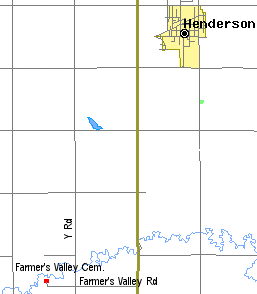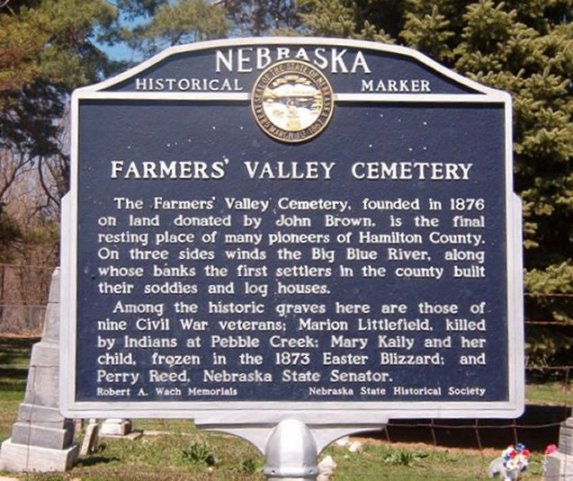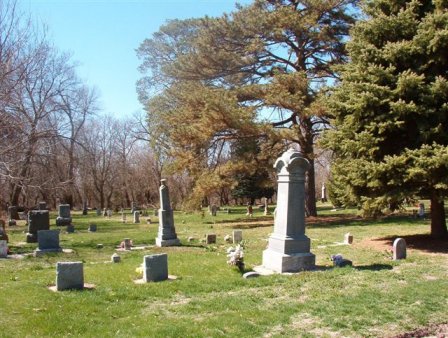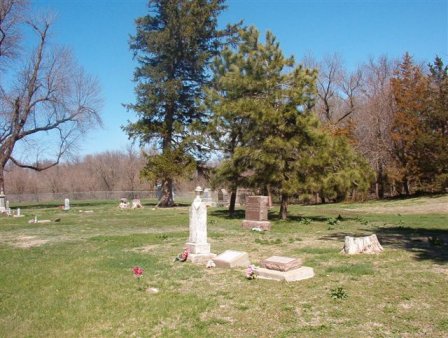 |
 |
 | |
 |
 |
 | |
|
The following newspaper article about Farmer's Valley Cemetery was published in the Sunday Journal and Star, Lincoln, Nebraska, Sunday July 15, 1934. Submitted by Jackie Rudnick. Jackie has also sent in photos of some of the tombstones and the cemetery. |
|
Sunday Journal and Star Nature's Serenity Adorns Old Burying GroundBy Sibyl B. JarrettIt is an old burying-ground, this little, country cemetery, sheltered by the greenery of trees, resting as it were in the friendly arms of the Blue River, for the river surrounds it on three sides. It is a historic burying-ground, Farmer's Valley cemetery, for many of the men and women now resting there have helped to make the early history of Hamilton county. A winding road, in and out along the "Blue" under a luxurious canopy of green, takes you to this time-worn country cemetery. You pass a school-house just an arm's throw from the old burying ground, which happen to be the original site of the old, log school-house built in 1870, the first school established in Hamilton county, the ground being a gift from James Waddle, a prominent and one of the very earliest settlers of Farmer's Valley. Just beyond the school house the road dips into a little hollow, turns gently and you enter the old Farmer's Valley burying-ground: a strangely silent, shadowed place, intermittent with sunshine. A quiet holiness, a feeling almost of restfulness comes over you while lines from the great Elegy steal into your heart. An acreage of the dead closed in on three sides by the dense foliage of the "Blue." --a wilderness of sumac in which the bittersweet inter-twines with the wild grape and upheld as it were here and there by age-worn woodbine which forms a wall on three sides of the old burying-ground. Pines Stand Sentinel Nature pays her tribute to the dead. In wild roses blooming in profusion in and out around the old graves. The word "old" must be used very often in the mind's eye of Farmer's Valley cemetery. For everything about it is old.-- the old river, the old trees, the old worn moss-covered stones.-- it is true there are a few graves of later years sloping toward the east of the four acreage of the dead, but you forget them in the hushed stillness of the place and see only the old stones where often it is necessary to stoop very, very low to read the curious, old style biographical epitaph. Pioneers At Rest This first settlement was made by a group of eastern people, largely from Wisconsin. Some of them were college-bred, who had come into the middle west as early as 1866 for the purpose of establishing farm homes. They settled on the Blue river and organized the first settlement of Hamilton county, known as Farmer's Valley. Jarvis Chaffee and George Hichs made the first entry on the river. Mr. Chaffee built a "dug-out" which was the first abode constructed in Hamilton county, its size being 10 by 12 feet. Next came James Waddle and John Brown, leaders of the Scottish colony in 1867. They built the first "log house" in Hamilton county. John Brown gave to the new settlement four acres of land for the purpose of a burying ground and which is the present Farmer's Valley cemetery. Mr. Waddle became an extensive landowner and in one year alone set out over 6,000 catalpa trees, enclosing his ground. The original homestead is known today as the "old Waddle place". The Complete Life The death of Mrs. Cordelia Westcott, wife of J.D. Westcott, brought the first burial in Farmer's Valley cemetery. Age has not entirely dimmed the inscription on the old, moss eaten stone on the very bank of the river. It reads "In memory of Cordelia Westcott, age 50 years, 3 mo, 23 days. Died August 28th 1867". Mrs. C.M. Bray, daughter of Mrs. Westcott, in speaking of her mother's death in a letter many years ago, said, "We thought we would have to take a wagon box to make a coffin for my mother, but E.D. Copsey had come here and taken a claim and brought some lumber to make a door and some window frames. He let us have that and Mr. Henderson made the coffin and my father and I lined it." This was the first casket that was lowered in Farmer's Valley cemetery. There are two little graves beside Mrs. Westcott's, her children who died in 1878, victims of a diphtheria epidemic that brought terror and grief to the early settlers. "Remember Friend" Mary F. Kaily, 23, and her little son Otto S., age 4, lost their lives in the great Easter snow storm, April 13, 1873. It was a storm that raged with great fury over the plains for three days and nights. The air was filled with a blinding cloud of snow, which was so dense as to render objects at a few yards distance entirely invisible. The Kaileys had come to the settlement on the "Blue" a year before from the east. Their log house while comfortable enough in ordinary weather proved unfit for the onslaught of the blizzard. Mrs. Kaily with the little boy in her arms left the house to go to her brother-in-law. The fury of the storm over-powered her. Victim of Indians
The story of Marion Littlefield's death is as follows: The settlers were in grave danger from the raids of the Indians who came down from the northern part of the state. In 1874 the settlements had extended to Burwell, and in January, the Indian troubles there broke loose when a marauding band visited a log-house occupied by several trappers, and in the absence of the owners, cleaned out the place. Sixteen men, under the command of Charley White (Buckskin Charley) volunteered to pursue the Indians. One of the party was a young fellow, Marion Littlefield, 23 years old, who no doubt looked upon it as a bit of adventure. They made their way to Peble Creek (across the river from Burwell). Just at dawn they were within 300 yards of the big tepee. Cautioning the men to keep silent, White entered the camp and demanded the return of the property. He found the Indians breakfasting on the remains of their last night's feast and in no humor to compromise. Finds Indian Defiant The Indians opened fire as they reached the bank. It was promptly returned and for ten minutes the roar of musketry was like that of other days experienced at Rosebud Creek. The lonely bluffs of the Loup echoed the sharp crack of the rifles of white men and red engaged in a mortal combat. It was soon discovered that owing to the extreme cold the shells were sticking to the guns of the white men, retarding their fire. The Indians divided, half of them crawling along to the rear, protected by a little ridge running parallel to the river. They say that the white men had the advantage of a perfect protection from their bullets. While they were under the bank they could return the fire without exposing themselves. It was to get a better range at the white men that the Indians divided. Shot in Head The next day a sad little party passed down the valley--the friends of Marion Littlefield taking his body back to the home of his parents. He was a promising young fellow, a favorite with all his friends. His death was a fearful blow to his family and cast a gloom over the entire settlement. Marion Littlefield is resting today in the old, historic burying ground of Farmer's Valley where he was buried 60 years ago. **Note from Kathie Harrison: Marion Littlefield's sister married Buckskin Charley White, who's daughter married into my OWEN family** Lieutenant Alexander Jackson, Civil War veteran, Co. K, 18th Wisconsin Infantry, one of five other G.A.R. soldiers, was laid to rest in the old cemetery on the river, but the only one of the group whose grave is marked with a government stone. Lieutenant Jackson's father, known as "Father Jackson", was the oldest member of Farmer's Valley settlement. He was their religious leader and organized the first Sunday school. John Brown's Life John Brown was a sailor, had served in the navy for many, many years and had seen extensive travel all over the world. He served in the Crimean war, a war that has almost passed from memory as a war of yesterday. Once while on the Mediterranean sea his ship encountered serious danger, it was only by presence of mind and great bravery that a catastrophe was avoided. The people on board showed their gratitude to John Brown by presenting him with a very handsome watch and chain. The descendants of Brown still have sections of the watch chain in their possession, a gift bestowed sometime along 1850. John Brown was a man of great strength, a man who had seen life in many places under various conditions and who is resting today on the bank of the Blue river, under a magnificent cinnamon pine, in old Farmer's Valley burying ground. Built First Frame House It was not always "old age" found on the worn, yellow, moss-eaten stones in this old burying ground. Many a child's grave, a slab here and one there, showing an early date, bore mute testimony as to time, in some cases the little one's name was barely decipherable and the rest of the inscription lost. One infant grave was particularly appealing, a time worn slab with the words
Another was a quaint, child's stone adorned with a little lamb,
Two other early graves, Elijah Jackson and his wife Mary Ann who died in 1872 and were the parents of Daisy and Anny Jackson, well known in the teaching profession. They taught in the early days in Hamilton county, later they found responsible positions in Japan and the Hawaiian Islands. The Jacksons were part of the first settlement in Hamilton County. Decoration Day Rites The little child buried 60 years ago would be a white-haired man or woman now, but in the eyes of the school children, time is forgotten, and the "Little Singer" Johnnie is still looked upon as 2 years old. A lovely thought to know that the old graves are not forgotten. Little children lying side by side with many an old settler who was prominently identified with the early history of Hamilton county, have passed over the river in the late seventies or early eighties and settled in that country, "from whose bourne no traveler ever returns". |
 |  |
| Cornelia M. Bray 1845-1933 In Memory of Mother | Tombstone |
| John Brown Dec. 28, 1808 July ??, 18?? | Tombstone Close-up |
| F.H. Clark May 21, 1843 - Dec. 17, 1906 (Frederick) Lucy A. Clark His Wife Jan. 29, 1842 - Mar. 5, 1907 | Tombstone |
| Lieut. Alex. Jackson Co. K, 18th Wisc. Inf. | Tombstone Close-up |
| Elijah Jackson Born Sept. 2, 1805 Died Jan. 23, 1880 | Tombstone |
| Mary Ann Jackson Born June 19, 1807 Died March 20, 1889 | Tombstone |
| Mary F. Kaily Wife of F. Kaily Died Apr. 17, 1873 Aged 23 years Otto E. Kaily Son of F. & M.F. Kaily Died Apr. 17, 1873 Aged 4 years | Tombstone |
| Marion J. Littlefield Died Jan. 20, 1874 Aged 23yrs 2mos | Tombstone |
| Johnnie M. Pearse Son of Jas. M. & Mary S. Pearse Died Apr. 28, 1877 Aged 2yrs 8mos | Tombstone Close-up |
| Jimmie Stephens Son of A.R. & N.S. Stephens Died Dec. 2, 1885 Aged 5yrs 9mos | Tombstone |
| Cordelia Wescott died Aug. 28, 1862 | Tombstone Close-up |
| J.D. Westcott 1813-1896 Julia Westcott 1841-1913 | Tombstone |
| Ella M. White Wife of Chas. White Died Oct. 25, 1894 Aged 41Yrs. 2Mo 9Da | Tombstone |